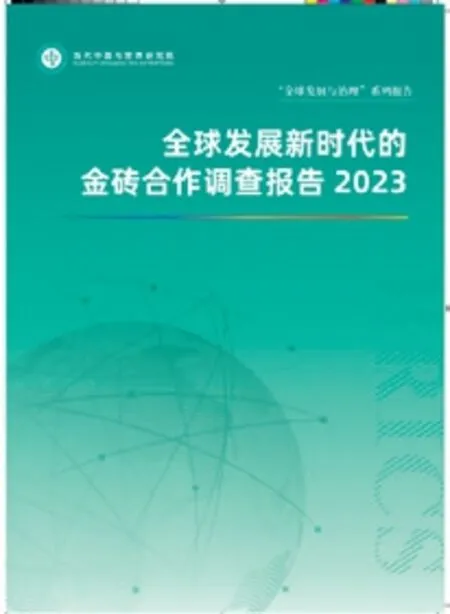ECONOMY/SOCIETY
2023-10-11

China’s Digital Trade in 2023
A report Digital Trade: Development and Cooperation 2023 was released at the recent Forum on Development of Trade in Services during the China lnternational Fair for Trade in Services (ClFTlS),showing that China’s international competitiveness in digital services trade has further strengthened.


Exports Show Steady Growth in First Eight Months
In the first eight months of this year,China’s total import and export value of the goods trade amounted to RMB 27.08 trillion (US $3.69 trillion).Despite a slight decrease of 0.1 percent yearon-year,the scale is still at a historical high for the same period,according to data released by the General Administration of Customs
The first eight months saw China’s imports and exports remain nearly unchanged year-on-year,and the overall operation of foreign trade remained stable.Against the backdrop of sluggish global economic and trade growth,in the first eight months,China’s exports showed growth and its international market share remained stable.
The export scale rebounded to over RMB 2 trillion(US $272 billion) in July,and further expanded in August,achieving month-on-month growth for three consecutive months.
The import and export scale in August increased by 8.2 percent compared to the average of the same period from 2020 to 2022,making it the second highest point in history.
China Unveils Action Plan to Step up Metaverse Development
China has unveiled a threeyear action plan to promote innovative development of its metaverse industry,according to the Ministry of Industry and Information Technology.
The plan detailed measures,including building advanced metaverse technologies and industrial systems to boost sector growth in the 2023-2025 timeframe.
By 2025,breakthroughs should be made in metaverse technologies,industries,applications,and other areas,and the metaverse will become an important growth sector in the digital economy,according to the plan.
It aimed to cultivate three to five metaverse-related companies with global influence and build three to five industry clusters by 2025.

The plan also called for efforts to enhance the integrated innovation of key metaverse technologies and outlined a few key tasks in the industry.The number of listed companies in the high-end manufacturing sector has reached 2,021 in China as of September 7,accounting for 57 percent of manufacturing companies listed on the A-share market,amid policy support,structural transformation,and upgrading of Chinese industries.ln the manufacturing sector,semiconductor and high-end machinery manufacturers have seen some of the most robust development.
57 Percent

Chinese Aircraft Maker Receives Over 1,000 C919 Jet Orders
Orders for China’s homegrown C919 jet have reached 1,061,according to the Commercial Aircraft Corporation of China,Ltd.(COMAC),at the recent 16th Pujiang Innovation Forum.
According to the aircraft maker,which developed the C919 and ARJ21 jetliners,China’s domestically-produced passenger aircraft sector has formed a product lineup ranging from regional aircraft,shortto medium-haul narrow-body aircraft,and long-haul widebody aircraft.
In December 2022,the inaugural customer of C919,China Eastern Airlines,received the first batch of deliveries,with commercial operations beginning in May 2023.Two aircraft are actively serving on the route between Shanghai and Chengdu operated by the airline.

China Shows Its Strength in New Energy
Chinese companies have overtaken their United States counterparts in number on this year’s Fortune Global 500 list.The list was unveiled on August 2 and tracks the revenue of the world’s richest enterprises.A total of 142 Chinese companies,including those in Taiwan,made it to the annual list,marking the fifth consecutive year that the number of Chinese companies has topped the list.The U.S.and Japan followed with 136 and 41 enterprises,respectively.
Industry experts said the list shows China’s growing prowess in emerging sectors,such as new energy,on the global stage.China’s Contemporary Amperex Technology Co.Ltd.— the world’s largest electric vehicle battery maker —debuted on the list this year and ranked 292nd.Another Chinese company,new energy vehicle manufacturer BYD,jumped 12 spots compared with last year to rank 212th.In total,nine Chinese vehicle manufacturers have made it to the list,and most of them are gaining ground in the field of new energy vehicle (NEV) technology.
Wang Peng,a senior researcher at the Beijing Academy of Social Sciences,said this collective performance of Chinese companies demonstrates China’s increasing international influence in the new energy sector.“China has gained momentum in NEV-related technologies and products in recent years,” he said.
Many Chinese NEV companies have taken the lead globally in the new energy sector with their technological breakthroughs,according to Wang.He said that given the country’s huge market,“Chinese companies in the new energy sector are expected to have more presence on the global stage during the coming years.”
Sunlight for Recycling Plastic Waste
A team at East China Normal University (ECNU) in Shanghai has made a breakthrough in recycling plastic waste utilizing seawater and sunlight,a process which is low in costs,environmentally friendly,and economically viable.
The method discovered by a research team led by Jiang Xuefeng,a professor at the School of Chemistry and Molecular Engineering at ECNU,uses sunlight to break down the plastics at room temperature and ambient pressure.The catalyst used in the process,uranyl cation,is a type of nonradioactive uranium that is abundant in seawater and can be easily extracted.
The research team has successfully degraded nine common types of plastic into raw materials,which can be used to produce improved plastics as well as new ones.The method can also be used in other applications such as pharmaceuticals,fragrances,and producing materials.
“Previously,the natural decomposition of these plastics would take decades or even centuries,” Jiang said.“But by using this method,we can decompose them within a day or two while obtaining commercial chemicals and monomers (molecules that can form polymers) such as benzoic acid and terephthalic acid,which are high-value fine chemicals.”

Global Support for China-Proposed Initiatives &BRICS
At the BRICS Seminar on Governance and Cultural Exchange Forum held in August in South Africa,the Academy of Contemporary China and World Studies released the reportGlobalSurvey:BRICSCooperationinthe NewEraofGlobalDevelopment2023.
Based on feedback of 10,000 people from 25 countries around the world,the report concludes that major Chinese ideas,such as a global community of shared future,common values of humanity,shared growth through consultation and collaboration in global governance,are widely endorsed by most respondents (91 percent),who believe they provide important inspiration for global development and governance.The approval rating is higher in member countries of BRICS (94 percent) and people aged 18-35 (92 percent).
The Global Development Initiative proposed by China wins support from 93 percent or more of the respondents in the 25 countries covered by the survey,with the two principles “taking a people-centered approach” and “being committed to resultsoriented actions” cited as the most appealing.In BRICS,the principle of “promoting harmony between humanity and nature” has the backing of 97.6 percent of local people.
The Global Security Initiative,also proposed by China,is popular (92 percent)as well.The principle that resonates most among BRICS people is “resolving differences and disputes between countries through dialogue,consultation and other peaceful means” (97 percent),and the one that received the highest support in other developing countries is “respecting the sovereignty and territorial integrity of all countries” (93.8 percent).
As many as 95.5 percent of respondents agree to the important role that the BRICS mechanism plays in international affairs,an increase of 2.5 percent from last year.And they share the view that BRICS members should help forge high-quality partnerships.

